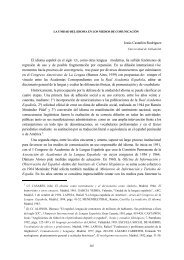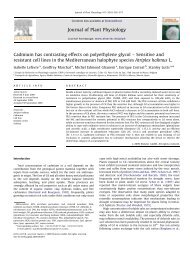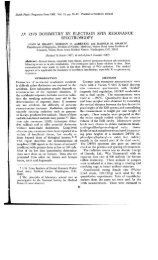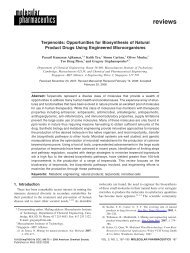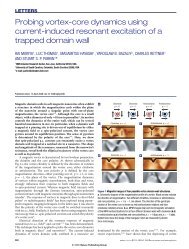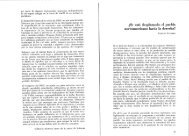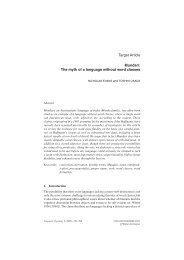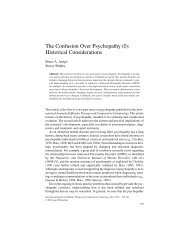Volatile composition of oak and chestnut woods used in brandy ...
Volatile composition of oak and chestnut woods used in brandy ...
Volatile composition of oak and chestnut woods used in brandy ...
Create successful ePaper yourself
Turn your PDF publications into a flip-book with our unique Google optimized e-Paper software.
210 I. Caldeira et al. / Journal <strong>of</strong> Food Eng<strong>in</strong>eer<strong>in</strong>g 76 (2006) 202–211<br />
level had only effect on the contents <strong>of</strong> this compound<br />
for CNF <strong>and</strong> CFL <strong>woods</strong>.<br />
For the majority <strong>of</strong> the acids the toast<strong>in</strong>g process<br />
does not affect their contents, except for hexanoic <strong>and</strong><br />
propanoic acids. For the former it was found a decrease<br />
with the <strong>in</strong>crease <strong>in</strong> the toast<strong>in</strong>g level <strong>and</strong> also it was detected<br />
effect <strong>of</strong> <strong>in</strong>teraction factors; so the toast<strong>in</strong>g process<br />
only affected the hexanoic levels <strong>of</strong> five types <strong>of</strong><br />
wood (CNF, CNG, CAST, CFA <strong>and</strong> CAM). Toast<strong>in</strong>g<br />
effect <strong>and</strong> <strong>in</strong>teraction effect was also detected for propanoic<br />
acid. For CNF, CAST <strong>and</strong> CFA the toast<strong>in</strong>g level<br />
did not affect the propanoic acid contents, although <strong>in</strong><br />
the other types <strong>of</strong> wood studied, higher toast<strong>in</strong>g level <strong>in</strong>creased<br />
the quantity <strong>of</strong> this compound.<br />
It can be also noted that the toast<strong>in</strong>g level effect on<br />
the amounts <strong>of</strong> cis-b-methyl-c-octalactone + 4-methylguaiacol<br />
was significant, but for the trans-b-methyl-coctalactone<br />
the toast<strong>in</strong>g do not affect itÕs contents, which<br />
disagree with the results obta<strong>in</strong>ed us<strong>in</strong>g French <strong>oak</strong><br />
wood by Chatonnet et al. (1989).<br />
The pr<strong>in</strong>cipal component analysis (Fig. 5) shows that<br />
the <strong>in</strong>itial wood group division, made by the first component,<br />
seems based on the toast<strong>in</strong>g level, which <strong>in</strong>creases<br />
across the component. In fact the unheated<br />
<strong>woods</strong> are located <strong>in</strong> the negative branch <strong>of</strong> this component,<br />
<strong>in</strong> opposite to the strongly toasted <strong>woods</strong>, which<br />
are located <strong>in</strong> positive branch <strong>of</strong> this component. Nevertheless<br />
it seems that the division between the successive<br />
toast<strong>in</strong>g levels is not clear. This could be due to the<br />
strong variability result<strong>in</strong>g from many uncontrolled<br />
parameters dur<strong>in</strong>g the heat treatment.<br />
The variables, which <strong>in</strong>fluence most the first component,<br />
are the furanic aldehydes (furfural, 5-methyl-furfural,<br />
HMF), 4-hydroxy-2-butenoic acid lactone, vannil<strong>in</strong>,<br />
propanoic acid <strong>and</strong> volatile phenols with a syr<strong>in</strong>gyl-type<br />
structure, namely syr<strong>in</strong>gol <strong>and</strong> 4-allyl-syr<strong>in</strong>gol. The <strong>in</strong>crease<br />
<strong>in</strong> toast<strong>in</strong>g level enhances the quantity <strong>of</strong> these<br />
compounds <strong>in</strong> wood. These results could expla<strong>in</strong> the<br />
sensory significant differences found <strong>in</strong> the br<strong>and</strong>ies<br />
aged, <strong>in</strong> these barrels (Caldeira, Belchior, Clímaco, &<br />
Bruno de Sousa, 2002).<br />
4. Conclusions<br />
This present work permitted the identification, for the<br />
first time, <strong>of</strong> the 4-hydroxy-2-butenoic acid lactone <strong>in</strong><br />
<strong>oak</strong> <strong>and</strong> <strong>chestnut</strong> wood, moreover, also for the first<br />
time, 2 + 3-methyl-1-butanol, benzaldehyde, acetovanillone,<br />
b-methyl-c-octalactone, guaiacol, 4-methylguaiacol,<br />
4-propylguaiacol, 4-ethylguaiacol, eugenol,<br />
isoeugenol, 4-methylsyr<strong>in</strong>gol <strong>and</strong> 4-allyl-syr<strong>in</strong>gol were<br />
identified <strong>in</strong> <strong>chestnut</strong> wood.<br />
These results po<strong>in</strong>ted out that the unheated wood discrim<strong>in</strong>ation<br />
is possible based on certa<strong>in</strong> volatile compounds<br />
namely eugenol, cis-b-methyl-c-octalactone,<br />
furfural, 4-hydroxy-2-butenolactone, hexanoic acid<br />
<strong>and</strong> guaiacol. Nevertheless after the toast<strong>in</strong>g process,<br />
wood discrim<strong>in</strong>ation is weaker <strong>and</strong> it is only possible<br />
to discrim<strong>in</strong>ate the American <strong>oak</strong> wood from the other<br />
types <strong>of</strong> wood based on amounts <strong>of</strong> eugenol <strong>and</strong> cis-bmethyl-c-octalactone<br />
present.<br />
For the seven <strong>woods</strong> studied, <strong>in</strong>clud<strong>in</strong>g the Portuguese<br />
<strong>chestnut</strong>, this work showed that the <strong>in</strong>crease <strong>in</strong><br />
the level <strong>of</strong> toast<strong>in</strong>g is related to the <strong>in</strong>crease <strong>in</strong> the levels<br />
<strong>of</strong> many compounds. The most affected were furanic<br />
aldehydes (furfural, 5-methylfurfural, HMF), volatile<br />
phenols (syr<strong>in</strong>gol <strong>and</strong> 4-allyl-syr<strong>in</strong>gol), propanoic acid,<br />
4-hydroxy-2-butenolactone <strong>and</strong> vanill<strong>in</strong>.<br />
Acknowledgements<br />
The authors thank Madalena Miguel for technical<br />
assistance, Sun Baoshan <strong>and</strong> Marlene Vaz for manuscript<br />
revision <strong>and</strong> PAMAF-IED-2052 for the f<strong>in</strong>ancial<br />
support.<br />
References<br />
Abbott, N., Puech, J.-L., Bayonove, C., & Baumes, R. (1995).<br />
Determ<strong>in</strong>ation <strong>of</strong> the aroma threshold <strong>of</strong> cis <strong>and</strong> trans racemic<br />
forms <strong>of</strong> b-methyl-c-octalactone by gas chromatography-sniff<strong>in</strong>g<br />
analysis. American Journal <strong>of</strong> Enology <strong>and</strong> Viticulture, 46(3),<br />
292–294.<br />
Alford, E. D., & Leff<strong>in</strong>gwell. J. C. (1998). GC/MS <strong>of</strong> liquid ‘‘hardwood<br />
smoke’’ extract. Available from http://www.leff<strong>in</strong>gwell.com/<br />
smoke1.htm.<br />
Artajona, J. (1991). Caracterisation del roble según su origen y grado<br />
de tostado, mediante la utilizacion de GC y HPLC. Viticultura/<br />
Enologia Pr<strong>of</strong>esionalm, 14(5/6), 61–72.<br />
Belchior, A. P., Caldeira, I., Tralhão, G., Costa, S., Lopes, C., &<br />
Carvalho, E. (1998). Incidência da origem e queima da madeira de<br />
carvalho (Q. pyrenaica, Q. robur, Q. sessiflora, Q. alba/Q. stellata<br />
+ Q. lyrata/Q. bicolor) e de castanho (C. sativa) em características<br />
fisico-químicas e organolépticas de aguardentes Lour<strong>in</strong>hã em<br />
envelhecimento. Ciência e Técnica Vitiv<strong>in</strong>ícola, 13(1–2), 107–118.<br />
Boidron, J. N., Chatonnet, P., & Pons, M. (1988). Influence du bois sur<br />
certa<strong>in</strong>es substances odorantes des v<strong>in</strong>s. Connaissance de la Vigne et<br />
du V<strong>in</strong>, 22(4), 275–294.<br />
Borralho, A. C. R. (1994). Estudo de substâncias provenientes da<br />
madeira no envelhecimento de v<strong>in</strong>hos t<strong>in</strong>tos. Suas <strong>in</strong>cidências na<br />
qualidade. (pp. 27–35). Relatório f<strong>in</strong>al do curso de Engenharia<br />
Agro-Industrial, Universidade Técnica de Lisboa, Lisboa.<br />
Brenna, E., Fuganti, C., & Serra, S. (2003). Enantioselective perception<br />
<strong>of</strong> chiral odorants. Tetrahedron: Asymmetry, 14, 1–42.<br />
Caldeira, I. (2004). O aroma de aguardentes vínicas envelhecidas em<br />
madeira. Importância da tecnologia de tanoaria. (pp. 65–94).<br />
Dissertação para obtenção do grau de doutor em Engenharia<br />
Agro-Industrial, Instituto Superior de Agronomia–Universidade<br />
Técnica de Lisboa, Lisboa.<br />
Caldeira, I., Belchior, A. P., Clímaco, M. C., & Bruno de Sousa, R.<br />
(2002). Aroma pr<strong>of</strong>ile <strong>of</strong> portuguese br<strong>and</strong>ies aged <strong>in</strong> <strong>chestnut</strong> <strong>and</strong><br />
<strong>oak</strong> <strong>woods</strong>. Analytica Chimica Acta, 458, 55–62.<br />
Caldeira, I., Canas, S., Costa, S., Lopes, C., Carvalho, E., & Belchior,<br />
A. P. (1998). Influence de lÕorig<strong>in</strong>e du bois et de la technologie de<br />
fabrication des fûts sur la qualité des eaux-de-vie Lour<strong>in</strong>hã pendant



